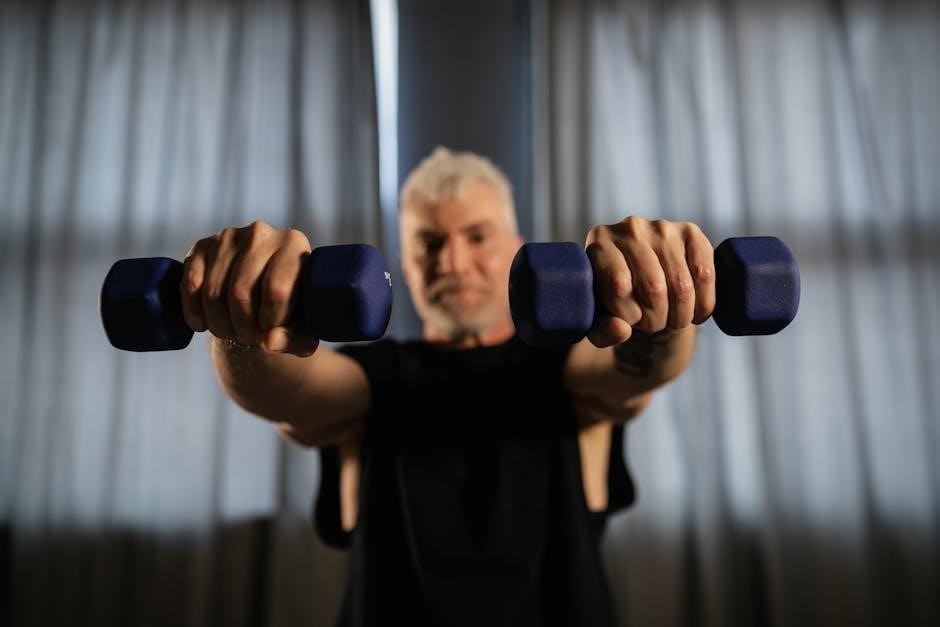Manual handling training in aged care is essential for caregivers to safely lift, transfer, and reposition residents, minimizing injury risks․ It focuses on proper techniques, equipment use, and hazard prevention․
What is Manual Handling Training?
Manual handling training in aged care refers to specialized instruction that teaches caregivers safe techniques for lifting, transferring, and repositioning residents․ It focuses on understanding the physical demands of manual tasks, such as pushing, pulling, and carrying, to minimize injury risks for both staff and residents․ The training emphasizes proper body mechanics, the use of mechanical aids, and hazard identification to ensure safe care delivery․ It is designed to equip caregivers with the skills and knowledge needed to perform manual handling tasks effectively while balancing resident care with workplace safety․
Why is Manual Handling Training Important in Aged Care?
Manual handling training is crucial in aged care to prevent injuries to both caregivers and residents․ It equips staff with techniques to safely lift, transfer, and reposition residents, reducing the risk of musculoskeletal injuries․ Proper training ensures compliance with workplace health and safety regulations, protecting facilities from legal liabilities․ By minimizing injuries, it also enhances resident well-being and maintains their dignity․ Effective manual handling practices contribute to a safer working environment and improve the overall quality of care provided to elderly residents, making it a cornerstone of aged care operations․
Risks and Hazards of Manual Handling in Aged Care
Manual handling in aged care poses risks of musculoskeletal injuries, physical strain, and accidents due to heavy lifting, repetitive tasks, and unpredictable resident movements, causing long-term harm to caregivers and residents․
Musculoskeletal Injuries in Caregivers
Musculoskeletal injuries are a common risk for caregivers in aged care due to repetitive lifting, transferring, and repositioning of residents․ Improper lifting techniques and handling heavy loads without assistance often lead to back strain, shoulder injuries, and other musculoskeletal disorders․ These injuries can result in chronic pain, reduced mobility, and long-term health issues for caregivers․ Additionally, they may lead to absenteeism and decreased quality of care for residents․ Addressing these risks through proper training and equipment is critical to safeguarding both caregivers and residents in aged care settings;
Risks to Residents During Handling
Risks to residents during handling include physical injuries and emotional trauma․ Improper lifting techniques can lead to bruises, fractures, or dislocations․ Residents, especially those with limited mobility or unpredictable movements, are vulnerable to accidents during transfers․ These incidents can result in pain, loss of dignity, and long-term health complications for residents․ Ensuring caregivers are well-trained in safe handling practices is crucial to minimizing these risks and maintaining a high standard of care in aged care settings․
Benefits of Manual Handling Training
Manual handling training enhances safety and efficiency in aged care, ensuring compliance with standards, reducing workplace injuries, and improving overall care quality for residents․
Compliance with Accreditation Standards
Manual handling training ensures aged care facilities comply with workplace health and safety regulations and accreditation standards․ It teaches caregivers to follow safe practices, conduct risk assessments, and use equipment properly․ Compliance reduces legal risks and potential penalties, ensuring the facility meets mandatory requirements․ Training programs align with industry standards, covering proper lifting techniques, hazard identification, and the use of mechanical aids․ By adhering to these standards, aged care providers demonstrate their commitment to resident and staff safety, maintaining trust and reputation․ Regular updates in training ensure ongoing compliance with evolving regulations and best practices in the sector․
Reduction in Workplace Injuries
Manual handling training significantly reduces workplace injuries in aged care by teaching caregivers safe lifting, transferring, and repositioning techniques․ Proper training minimizes the risk of musculoskeletal injuries, a common issue among care workers․ By learning how to use mechanical aids and identify hazards, staff can prevent accidents․ The training also emphasizes correct body mechanics and posture, further reducing injury risks; As a result, injured workers and absentees decrease, creating a safer environment for both caregivers and residents․ Safe practices lead to fewer injuries, improving overall workplace safety and quality of care provided to residents․
Enhanced Quality of Care for Residents
Manual handling training enhances the quality of care for residents by teaching caregivers safe techniques for lifting, transferring, and repositioning․ This reduces the risk of injury and discomfort for residents, ensuring they are handled with dignity․ Proper training also minimizes the use of force, making care more respectful and considerate․ Additionally, it fosters a safer and more comfortable living environment, which is vital for residents’ well-being and satisfaction․
Essential Skills and Techniques Taught in Manual Handling Training
Manual handling training teaches safe lifting, transferring, and repositioning techniques, proper body mechanics, and the use of mechanical aids to minimize injury risks and enhance care efficiency․
Safe Lifting and Transferring Techniques
Safe lifting and transferring techniques are critical in aged care to prevent injuries to both caregivers and residents․ Proper methods include bending at the knees, maintaining a neutral spine, and using leg strength instead of back muscles․ Caregivers are taught to assess the resident’s weight and mobility to determine the safest approach․ Techniques may involve sliding, pivoting, or using assistive devices like slide sheets or hoists․ Team lifting is often recommended for heavier residents․ Training emphasizes communication with the resident to ensure cooperation and comfort during transfers․ These techniques minimize strain and reduce the risk of musculoskeletal injuries for staff․
Use of Mechanical Aids in Aged Care
Mechanical aids are essential in aged care to reduce manual handling risks and enhance resident safety․ Devices like hoists, slide sheets, and lifters minimize physical strain during transfers․ Ceiling-mounted or stand-alone hoists allow caregivers to safely lift residents with minimal effort․ Slide sheets reduce friction when repositioning residents in bed or chairs․ Proper training on these tools ensures efficient and dignified care․ Mechanical aids not only protect caregivers from injury but also promote resident comfort and independence․ Their use is a cornerstone of modern aged care practices, emphasizing safety and efficiency in daily care tasks․
Proper Body Mechanics and Posture
Proper body mechanics and posture are critical in manual handling to prevent injuries and ensure safe care․ Caregivers are taught to maintain a neutral spine, engage core muscles, and avoid rounding the back․ When lifting, bending at the knees and hips is emphasized, with weight distributed evenly․ Keeping the resident close to the body reduces strain․ Training also covers balanced stance, foot placement, and smooth movements․ These techniques minimize the risk of musculoskeletal injuries and promote efficient, safe handling․ Proper posture and alignment are reinforced through practical exercises and demonstrations, ensuring caregivers can apply these principles effectively in real-life scenarios․

Legislation and Compliance in Manual Handling
Manual handling training must comply with workplace health and safety regulations and aged care standards, ensuring safe practices and legal adherence to protect both staff and residents․
Workplace Health and Safety Regulations
Workplace health and safety regulations mandate that aged care facilities implement safe manual handling practices to protect both caregivers and residents․ Employers must conduct risk assessments, provide proper training, and ensure the use of appropriate equipment to minimize injuries․ Compliance with these regulations is crucial to avoid legal penalties and ensure a safe working environment․ Regular audits and updates to training programs are required to maintain adherence to evolving standards․ Failure to comply can result in severe consequences, including workplace injuries and legal action, emphasizing the importance of prioritizing safety in all manual handling tasks․
Standards for Aged Care Facilities
Aged care facilities must adhere to strict standards ensuring safe manual handling practices․ These standards require staff to undergo regular training, use appropriate equipment, and follow established protocols to minimize risks․ Facilities are expected to conduct thorough risk assessments and implement strategies to reduce hazards․ Compliance with these standards is essential for maintaining accreditation and providing high-quality care․ The standards also emphasize the importance of staying updated with best practices and technologies in manual handling․ By meeting these standards, aged care facilities create a safer environment for both residents and caregivers, ensuring dignity and well-being in care delivery․
Case Studies and Real-Life Examples
Case studies highlight successful manual handling practices in aged care, demonstrating how proper training reduced injuries and improved resident care quality, setting benchmarks for safety․
Successful Implementation of Manual Handling Practices
Successful implementation of manual handling practices in aged care involves practical training, interactive sessions, and real-life simulations․ Many facilities have reported significant reductions in workplace injuries after adopting tailored programs․ For instance, one aged care facility reduced caregiver injuries by 40% by integrating hands-on training and mechanical aid demonstrations․ These programs often include personalized feedback, ensuring staff master safe lifting and transferring techniques․ The involvement of physiotherapists and occupational therapists further enhances the effectiveness of these initiatives, leading to improved resident safety and overall care quality․
Common Mistakes and Their Consequences
Common mistakes in manual handling include ignoring proper lifting techniques, overreliance on physical strength, and poor posture․ These errors often result in musculoskeletal injuries to caregivers and potential harm to residents․ For instance, lifting residents without using mechanical aids or bending at the waist can lead to strains and long-term health issues․ Additionally, failing to assess a resident’s weight or mobility before handling increases accident risks․ Such oversights not only compromise care quality but also lead to workplace injuries, highlighting the importance of adhering to trained practices and using available equipment to ensure safety for both caregivers and residents․

The Role of Practical Training Sessions
Practical training sessions provide hands-on experience, enabling caregivers to master safe manual handling techniques through real-life simulations, reducing injury risks, and enhancing care quality for residents․
Hands-On Training for Caregivers
Hands-on training sessions are crucial for caregivers, providing practical experience in safely lifting, transferring, and repositioning residents․ These sessions simulate real-life scenarios, allowing caregivers to practice techniques like using hoists, slide sheets, and manual lifts under supervision․ Trainees learn to assess resident mobility, use proper body mechanics, and operate mechanical aids effectively․ Practical training builds confidence and competence, ensuring caregivers can apply safe handling practices consistently․ Regular hands-on exercises also help reinforce learning, reducing the risk of injuries to both caregivers and residents while maintaining a high standard of care in aged care settings․
Simulating Real-Life Scenarios in Training
Simulating real-life scenarios in manual handling training prepares caregivers for common challenges in aged care․ These simulations include transferring residents from beds to wheelchairs, assisting with falls, and repositioning immobile clients․ Trainees practice using hoists, slide sheets, and other equipment in realistic settings․ Scenarios are tailored to reflect everyday tasks, helping caregivers develop problem-solving skills and teamwork․ By mimicking real-world situations, training enhances confidence and ensures caregivers can respond safely and effectively․ This approach reduces errors and improves care quality, benefiting both staff and residents in aged care environments․
Importance of Regular Training and Updates
Regular manual handling training updates ensure caregivers stay informed about new techniques and safety protocols, reducing injury risks, improving care quality, and ensuring compliance with standards․
Refreshing Skills to Prevent Injuries
Regular manual handling training refreshes caregivers’ skills, ensuring they use proper techniques to prevent injuries․ This reduces musculoskeletal strains and workplace accidents, promoting a safer environment for both staff and residents․ Practical sessions focus on lifting, transferring, and repositioning, emphasizing body mechanics and posture․ Updates also address common mistakes, such as overreliance on strength rather than technique․ By reinforcing best practices, training helps caregivers adapt to resident needs while minimizing risks․ This ongoing education ensures compliance with safety standards and fosters a culture of care excellence, ultimately enhancing resident well-being and workplace safety․
Adapting to New Techniques and Technologies
Manual handling training increasingly incorporates new techniques and technologies to enhance safety and efficiency in aged care․ Advances such as mechanical lifting aids, exoskeletons, and interactive simulations are transforming how caregivers perform tasks․ These innovations reduce physical strain and improve precision when lifting or transferring residents․ Training programs now emphasize adapting to these tools, ensuring caregivers are proficient in their use․ Staying updated with emerging technologies not only prevents injuries but also elevates the quality of care provided; By integrating modern solutions, manual handling training prepares caregivers to meet the evolving demands of aged care while maintaining resident safety and dignity․

Challenges in Manual Handling Training
Manual handling training faces challenges like staff resistance to change and time constraints in busy aged care environments, impacting training effectiveness and consistency․
Resistance to Change Among Staff
Resistance to change is a significant challenge in manual handling training․ Many staff members may be hesitant to adopt new techniques, often due to ingrained habits or perceived time constraints․ This resistance can stem from a lack of understanding about the benefits of updated methods or skepticism about their effectiveness․ Additionally, some caregivers might feel that changing their practices could disrupt their workflow or require unnecessary effort․ Overcoming this resistance is crucial, as it directly impacts the safety and well-being of both caregivers and residents․ Engaging staff through interactive training and demonstrating real-world benefits can help address these concerns effectively․
Time Constraints in Busy Care Environments
Time constraints are a major challenge in implementing manual handling training within busy aged care settings․ Caregivers often juggle multiple responsibilities, leaving limited time for comprehensive training sessions․ This can lead to rushed or incomplete training, which may not adequately equip staff with essential skills․ Additionally, high patient-to-staff ratios and demanding care schedules can make it difficult to prioritize training․ As a result, caregivers may rely on familiar but potentially unsafe practices, increasing the risk of injuries to both themselves and residents․ Addressing time constraints requires innovative solutions, such as flexible training schedules or integrating training into daily workflows, to ensure staff can access and apply safe manual handling techniques effectively․

Engaging Family Caregivers in Manual Handling Training
Family caregivers play an essential role in providing care, and their involvement in manual handling training ensures they can safely assist loved ones, reducing injury risks․
Benefits for Family Members Involved in Care
Family caregivers benefit significantly from manual handling training, gaining confidence and skills to safely assist loved ones; This reduces injury risks for both caregivers and residents, improving care quality․ Training empowers family members to handle daily tasks more effectively, creating a safer home environment and strengthening their caregiving role․ It also fosters a collaborative approach, ensuring consistency in care practices․ By equipping family caregivers with proper techniques, manual handling training enhances overall well-being and safety for everyone involved․
Workshops and Resources for Family Caregivers
Family caregivers can access tailored workshops and resources to enhance their manual handling skills; These include interactive courses, practical training sessions, and online modules․ Resources such as instructional videos, downloadable guides, and case studies provide valuable insights․ Workshops often cover safe lifting techniques, proper body mechanics, and the use of mechanical aids․ Additionally, many organizations offer certification programs and ongoing support to ensure caregivers feel confident and prepared․ These resources empower family caregivers to provide safe, effective care while reducing the risk of injury to both themselves and their loved ones․
The Future of Manual Handling in Aged Care
The future of manual handling in aged care emphasizes emerging technologies, innovative techniques, and advanced training methods to enhance safety and efficiency in caregiving practices․
Emerging Technologies and Innovations
Emerging technologies in manual handling are transforming aged care, with innovations like mechanical lifting aids, exoskeletons, and AI-powered tools enhancing safety and efficiency․ Interactive training platforms, developed by industry experts, now offer personalized learning experiences․ Online certification courses provide accessible education for caregivers, ensuring they adopt the latest techniques․ These advancements not only reduce injury risks but also improve the quality of care for residents․ As technology evolves, it promises to further streamline manual handling practices, making them safer and more effective for both caregivers and those they support․
Trends in Safe Handling Practices
Current trends in safe handling practices emphasize personalized training programs tailored to specific care settings․ The integration of interactive technologies, such as virtual reality simulations, is becoming increasingly popular for immersive learning․ Mechanical aids, like powered hoists and sliding sheets, are being widely adopted to reduce physical strain․ Additionally, there is a growing focus on ergonomic assessments and dynamic risk assessments to adapt handling techniques to individual resident needs․ These advancements aim to create a safer environment for both caregivers and residents, promoting efficiency and compassion in aged care services․
